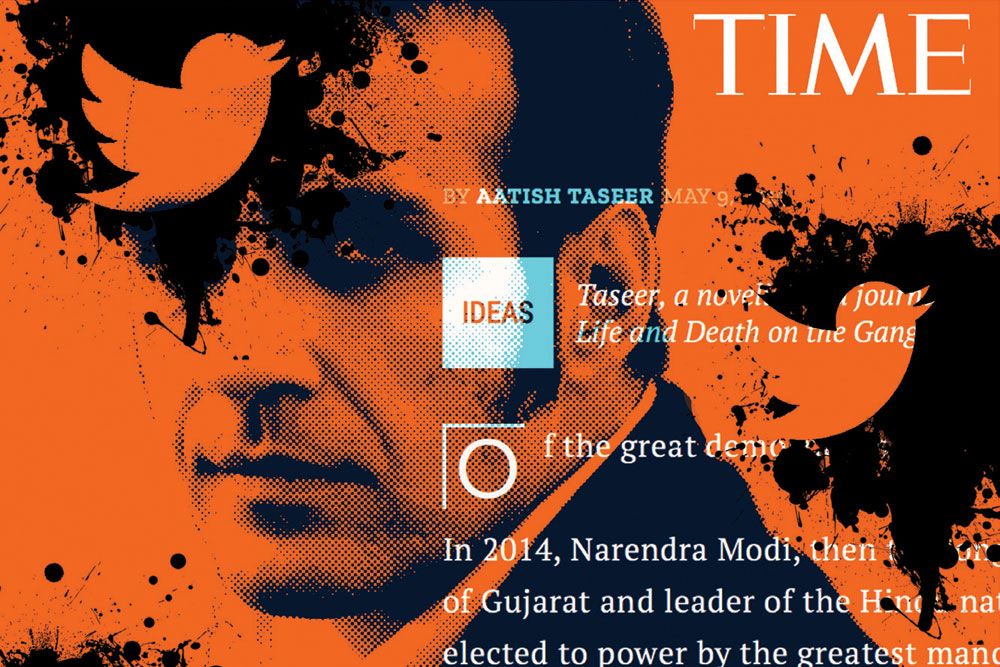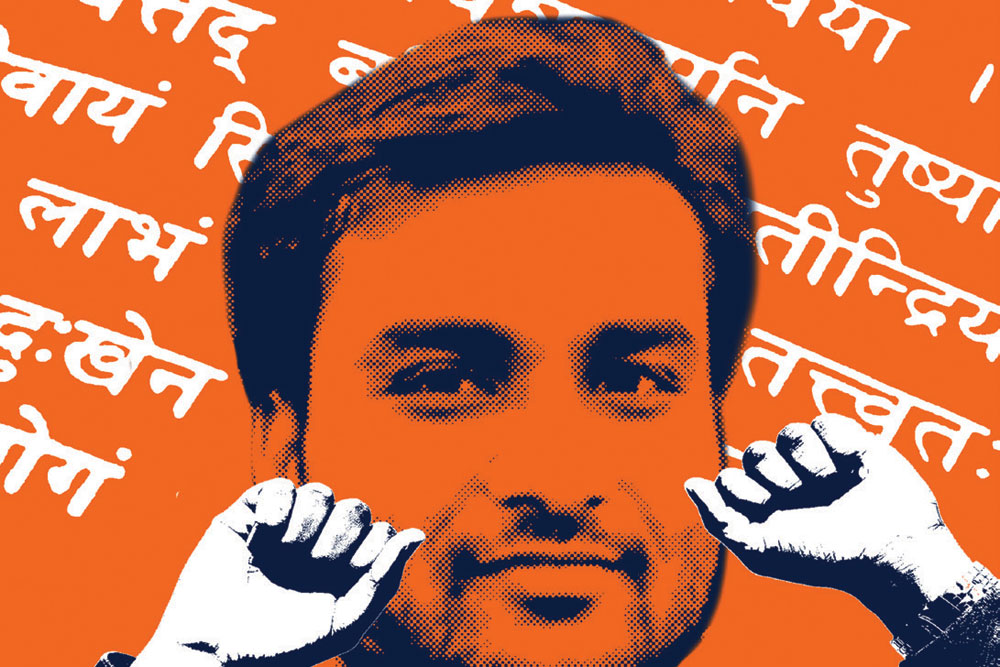Where is the Hindu Right Going?
Look who’s eroding the Modi ecosystem
 Rahul Pandita
Rahul Pandita
 Rahul Pandita
Rahul Pandita
 |
29 Nov, 2019
|
29 Nov, 2019
/wp-content/uploads/2019/11/Hinduright1.jpg)
(Illustration: Saurabh Singh)
THE BIGGEST ENDORSEMENT for Prime Minister Narendra Modi in the foreign press may have come in May this year. In a cover story for Time magazine, the writer and journalist Aatish Taseer wrote that Modi belonged ‘very firmly’ to the category of populists ‘who are of the people they represent,’ unlike the likes of Donald Trump or Imran Khan ‘who are merely exploiting the passions of those they are not actually part of’.
The piece appeared just before Modi became the first non-Congress leader to be elected twice with a clean majority. ‘He [Modi] is the son of a tea seller, and his election was nothing short of a class revolt at the ballot box,’ Taseer wrote, predicting Modi’s return to power. The piece also said what should have been music to Modi’s supporters: The Congress party had failed to practise secularism as an instrument of equal treatment of all religions by the state. Instead, Taseer wrote, it was turned into ‘Orwell’s maxim of some being more equal than others’ by allowing Indian Muslims to keep their own set of religious rules even as Hindus were subject to the law of the land.
But Taseer’s piece also conscientiously wrote about the shortcomings of Modi’s regime—how he had failed to deliver on his promise of an economic miracle, how cow-protection gangs were lynching people, and how someone like Sadhvi Pragya Thakur had been offered a chance to fight elections on a BJP ticket (which she won later). These are legitimate questions which anyone who has a little credibility and is writing on India’s current political spectre will mention. Taseer does that, and at the same time in a scathing critique of the Congress, writes how India’s oldest party has little to offer than send Priyanka Gandhi by her brother Rahul Gandhi’s side.
But when the story appeared, many staunch Modi supporters saw it as yet another Western media conspiracy to belittle Modi’s persona. Instead of choosing to read the article carefully, they began to simply outrage based on the headline Time had chosen to give to its story: ‘India’s Divider in Chief’. The nuances of a complex story which an astute writer like Taseer had written were lost on most of India’s Hindu Right. There is no understanding that a journalist’s currency is concomitant with his ability (and willingness) to throw light on both sides of the coin.
In no time, Taseer’s Pakistan background (his father, a Pakistani politician, was killed by an Islamist extremist) was invoked and he came to represent the worst of India’s liberal elite—‘the Khan Market gang’—as the Right calls them. It is another matter that most of those who use this label as an insult harbour a secret ambition to be a part of it.

On social media, it is rather easy to identify this section of the Reactionary Right. Their Twitter profile often identifies them as a ‘Hindu nationalist’, with a Sanskrit shloka thrown in for gravitas. In the likelihood of, say, a terrorist having died in an encounter with security forces in Kashmir, they are likely to tag Rajdeep Sardesai or Siddharth Varadarajan (‘Khan Market gang’) with a comment like: ‘You must be weeping silently.’ They will consistently engage with the academic Audrey Truschke but have no scholarship to counter her work. Many times, they will reply to some retired army general who may have tweeted something critical of the Government and ask him ‘What do you know of someone dying on the border?’ without even realising what service history that officer has had. An ecosystem which should have been battling for ideas is not fecund even in reaction.
Aatish Taseer’s Pakistan background was invoked and he came to represent the worst of India’s liberal elite —‘the Khan Market Gang’—as the right calls them. It is another matter that most of those who use this label as an insult harbor a secret ambition to be a part of it
For this section of the New Right, the past is the place to be. From the mysteries of mathematics to miracles of medicine, all repertoire of knowledge and scholarship existed in ancient India. While the achievements of ancient India are worthy indeed, this constant gazing at the past creates blockages in seeking a future which is not at odds with the modern world. The US-based academic and Mahabharata scholar, Vishwa Adluri, always insists that the book be treated as a practical guideline for living, “a textual universe precisely to reveal the narrative nature of our experience of the universe.” But instead of engaging with its ideas, the Right spends all its energies and resources on seminars where they discuss how utensils from that era were found in Kurukshetra. In such dogged attempts of preening purism, the message is lost, resulting in an inability to engage with ideas, forget diverse ideas.
“It is an acute inferiority complex that manifests itself into a superiority complex,” says Abhijeet Iyer-Mitra, a scholar who is on the Right side of the spectrum but often finds himself at the receiving end of barbs from the Reactionary Right. “Many of them think that they are the be-all and end-all and if a counter-idea does not fit into their worldview, it must then be a Western construct,” he says.
IT IS BECAUSE of its scant regard for original scholarship that the Hindu Right has never been able to acquire an intellectual muscle. Where is the scientific temperament? Where are the people who can rewrite histories, challenge biased Western scholars—all without making a mockery of scholarship? The Right’s need for one hundred per cent adherence to its line is absolute, and violation of it is deemed to be violating the laskhman rekha. Any intellectual worth her salt will apply mind and reason and then ally. There are scholars and academics and policy experts who feel a certain common ground and want to collaborate—on matters of security, on education, on health, on economics, to provide a much-needed intellectual impetus. But they cannot be turned into poodles who will nod at every word coming from Modi’s mouth or from those outside Government who claim to be running the Right discourse. That is why these scholars and experts remain chary of aligning themselves with the Government. And that is how the Right simply lacks talent and does not even have capable people with right credentials to run institutions. “They end up appointing caterers as vice chancellors of universities who then take them to the dark ages,” says an academic who identifies with the Right and does not wish to be named.

As engagement with a modern outlook remains meagre, it results in the Hindu Right becoming a mirror image of radical ideologies it claims to have been born as counter to. It then manifests in Banaras Hindu University where students wanted a Sanskrit professor, Feroz Khan, to be removed just because he is a Muslim. In Bulandshahr, it turns into the ugliness of the garlanding of the accused in the killing of Inspector Subodh Kumar Singh (in violence related to cow slaughter), after the former came out on bail. Social engineering in Uttar Pradesh is fine and so is patting oneself on the back that a part of Mayawati’s core electorate voted for the BJP last time; there have been no serious attempts to bridge the gap with the Dalit community that continues to remain the target of upper-caste violence. An undercurrent of orthodoxy has been set in motion which runs into the danger of becoming an end. From the old Right, a dismissal for, and a distrust of, the English-speaking class has also seeped in, which severely restricts its options of acceptance.
Recently, the Yogi Adityanath government spent Rs 1.33 crore on a festival in Ayodhya where over 500,000 earthen lamps were lit before Diwali. Around the same time, a young girl not far from the state capital Lucknow set herself afire as she could no longer bear the pangs of hunger. At the site of the festival in Ayodhya itself, some girls were seen draining oil from the earthen lamps into plastic bottles for consumption. A minor comment by me on Twitter about whether this was the Ram Rajya India aspired for sent a section of the Right into a tizzy. The same drab statements were hurled at me. ‘Why don’t you say this when goats are slaughtered on Eid?’ ‘Stop targeting Hindu festivals.’ Many of the reactionaries included prominent flagbearers of this Government. In my case, since I have a history of being a victim of Islamist extremism in Kashmir, terms like ‘Dhimmitude’ and ‘Stockholm syndrome’ are often used. Some go to the extent of saying that the Kashmiri Pandits deserved what happened to them because they have people like me. Reaction without sound reasoning is bound to manifest itself as intellectual dwarfism. In some of my earlier pieces, I had argued that the attempts of Leftists to equate holding of beef festivals in universities with Dalit empowerment are ludicrous. What is equally odious is this Right’s show of burning crackers for ‘Hindu empowerment’ at a time when many parts of the country are reeling under asthma-inducing bad air quality.
The Hindu Right is becoming a mirror image of radical ideologies it claims to have been born as counter to, manifesting in a BHU where students want Feroz Khan to be removed as a Sanskrit professor just because he is a Muslim
The worst participants among this reactionary core are the non-resident Indians. In their head, India has already reached the stage of Ram Rajya where rivers are overflowing with milk. Their tendency to idealise their place of origin makes them oblivious to any sense of proportion. “When my mother goes for sari shopping, she tells the salesman that she will break his head if he points out the NRI section to her,” Mitra quips. “The NRIs have the worst tastes and this reflects in their take on modern ideas and concerns of today,” he says. While it certainly is not true of all NRIs, the evidence on social media about the behaviour of a section of NRIs only serves as evidence for what Iyer-Mitra refers to.
While concern on issues like economic slowdown and authoritarianism remains, which many like Taseer do not fail to point out, instead of joining the small band advocating course correction, the Reactionary Right considers such harbingers of truth as enemies of the great Indic civilisation. Decent achievements are never enough; India’s sone ki chidiya moment is only in the absolutism of Modi’s words. For example, Modi’s personal initiative of cleanliness has set a great example. No matter where one goes, it is a message that has gone deep down. Now the Left and its adversaries may make fun of politicians doing photo-ops of running a broom over non-existent garbage, there is no doubt that the levels of cleanliness have gone up and people are increasingly reluctant to litter their neighbourhood. But if tomorrow one were to point to a heap of garbage in the neighbourhood or the fact that it would be extremely difficult to achieve a hundred per cent toilet penetration in India no matter what the Government may claim tomorrow, but there will be an immediate onslaught of reaction.
‘All conservatism begins with loss,’ writes the political commentator Andrew Sullivan in his book, The Conservative Soul (2006). While the sense of loss and its memory are important, these must not lead to drowsiness when it comes to thinking about what alternative the Right wants to offer to the Left which is not laughable or dangerous, or first laughable and then dangerous. While referring to the Left, Sullivan writes that they were ‘far more interested in exposing the iniquities and prejudices of their conservative enemies than in holding up a coherent, progressive, or egalitarian alternative to the new consensus.’ Invert this image and the New Right in India looks exactly as Sullivan describes the Left. The old systems have been gone for almost six years now. Instead of reckless blaming, the new responsibility is to build this alternative.
But the Right does not seem to be ready for it. In conferences and festivals espoused by the Right, approving the applause at displays of basal biases and statements does not look promising at all.
After Taseer’s Overseas Citizen of India (OCI) card was revoked, the cheerleaders with whom he has picked up many fights on Twitter, are in a jubilant mood. They have dug up his old statements, scrutinising them word by word in their hunger to prove that he has always been the ‘enemy’. They are not even sparing his mother, the journalist Tavleen Singh, who has been a subtle supporter of Modi, making vitriolic comments that she supported Modi only after she was shunned by the Congress.
For an establishment that has been running from pillar to post to find suitable voices to represent it in the Western media, in the wake of its actions in Kashmir, the Reactionary Right only makes sure that it remains stratified as a do-not-engage-with entity.
The Ram Temple, after all, can only make it sprint till a certain distance.

/wp-content/uploads/2025/07/Cover_Dalai-Lama.jpg)












More Columns
From Entertainment to Baiting Scammers, The Journey of Two YouTubers Madhavankutty Pillai
Siddaramaiah Suggests Vaccine Link in Hassan Deaths, Scientists Push Back Open
‘We build from scratch according to our clients’ requirements and that is the true sense of Make-in-India which we are trying to follow’ Moinak Mitra